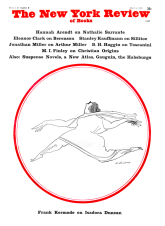The charting of Odysseus’s adventures is an age-old amusement. Mr. Bradford is the latest and not the least contributor to a debate which can have no end (and which from the point of view of pure reason, indeed, is a little futile). A skilled English yachtsman, he has sailed his boats into the remoter bays of the Mediterranean—no professional scholar, to be sure, but one who has read his Odyssey with lively enthusiasm and not infrequent discernment. His writing carries one along, though it is not exactly elegant, and I found this to be an enjoyable book even when I was disagreeing with it; though there are careless patches (especially in the first four chapters) and some incongruous fragments of fine writing, while the illustrations are quite inadequate. There are the usual enjoyable digs at classical scholars, a few of whose works he has read. Of course I thoroughly agree that some of them would benefit from a couple of years before the mast in the wine-dark sea—who wouldn’t?—just as I believe that Mr. Bradford himself would be the better for spending a like period in a good classical library. The trouble is that life is short, and that different kinds of persons must learn from each other, indirectly, if possible without pride. My observation has been that preoccupation with the most practical aspects of history is often occompanied by a weakness in theory. A working knowledge of sailing and the sea undoubtedly helps with certain problems of the Greek and Roman world, but it does not transform the scene quite so radically as our author suggests.
This is the route proposed for Odysseus on his long voyage home: [Troy—Thrace—C. Malea]—Jerba (the Lotus-eaters)—Favignana island, near Trapani (the Cyclopes)—Ustica, off the north coast of Sicily (Aeolus)—[nearly to Ithaca and back to Ustica]—Bonifacio, in southern Corsica (the Laestrygonians)—Cape Circeo, half-way down the west coast of Italy (Circe’s island)—the Straits of Gibraltar (entrance to Hades) and back—the Galli rocks, in the bay of Salerno (the Sirens’ island)—close to Stromboli and Strombolicchio (the Wandering Rocks)—the Strait of Messina (Scylla and Charybdis)—Taormina bay (the island of the cattle of the Sun)—[Messina strait again]—Malta/Gozo (Calypso’s island)—Corfu (Scheria)—Ithaca.
Many of these identifications are already familiar, though the combination is new. Mr. Bradford’s original contribution (apart from the freshness of his seaman’s viewpoint) lies in his claim that the courses and intervals of days indicated in the poem usually coincide exactly with his suggested route. Yet the identifications are often extremely questionable, and the arguments about courses and intervals are sometimes very strained indeed; sometimes, too, the text of Homer is not quite accurately reported. Thus it is true that Bonifacio resembles the description of the Laestrygonian harbor (which also represents, of course, an obvious sailor’s ideal), but it lies in completely the wrong direction for Odysseus’s crew to have rowed in; the Sirens lived on one island, not on two or more as the author says, which is just one more argument against taking the inconspicuous Galli rocks too seriously; there is a serious confusion in the Odyssey itself between the Wandering Rocks and Scylla-and-Charybdis, which Mr. Bradford does not notice and which damages his account of the relations between them; and the island of the Sun-cattle, like Circe’s, is clearly implied in the poem to be small and isolated, not a piece of a long, continuous coast. Statements like this are simply not true: “As for the description given by Circe of the Stromboli-Strombolicchio channel, and the description of Ulysses’ passage between the two Islands, it could not be bettered for clarity and definition.” Again, it is far less certain than the author suggests that only the North wind mentioned in the poem could take a square-rigged craft from Circeo to the Straits of Gibraltar. Moreover he conceals from himself and his readers some of the most pronounced anti-realistic parts of the Homeric descriptions (I do not mean things like the brazen walls of Aeolus’s palace, for which the expression “iron-bound coast” is aptly cited). Circe’s isle exists on a different plane from Monte Circeo: it is a magic place, in which even Odysseus cannot tell where east and west lie—something quite distinct from being “completely lost.” Similarly the ability of the Phaeacian ships to steer themselves is overlooked in the discussion of the voyage from Scheria to Ithaca. It is treated as a passage from Corfu to Ithaca-Thiaki in completely realistic terms. Here the author nods, even on his plane of realism: from Corfu to Ithaca is not seventy sea-miles but close on eighty, which makes it even more unlikely that the journey could be covered by any ancient ship within the limits of a summer’s night.
Advertisement
Mr. Bradford is too sensible to believe that Ulysses “really” sailed along this route, but he thinks the descriptions are founded on these particular places in this particular sequence, and that Homer “based the wanderings of Ulysses on the factual record of a real voyage.” I am not convinced. Some parts of the route seem clearly fictitious, others are likely to be conflated from so many diverse actualities, at so remote a degree of reportage, as to border on fiction. However, that some details of actual landfalls and actual harbors are incorporated I do not doubt, or that over parts of the route a broad sense of direction is preserved. That Charybdis, at least, reflects the Messina Strait with its completely real whirlpools seems as certain to me as it does to Mr. Bradford—and not only because I, too, have sailed through in my small boat, though that helps.
This Issue
March 5, 1964



